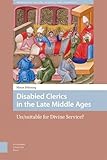Disabled Clerics in the Late Middle Ages : Un/suitable for Divine Service? / Ninon Dubourg.
Material type: TextSeries: Premodern Health, Disease, and Disability ; 8Publisher: Amsterdam : Amsterdam University Press, [2023]Copyright date: ©2023Description: 1 online resource (294 p.)Content type:
TextSeries: Premodern Health, Disease, and Disability ; 8Publisher: Amsterdam : Amsterdam University Press, [2023]Copyright date: ©2023Description: 1 online resource (294 p.)Content type: - 9789048554324
- Church history -- Middle Ages, 600-1500
- Clergy with disabilities
- Disabilities -- Religious aspects -- Christianity
- Health and Medicine
- High Middle Ages
- History, Art History, and Archaeology
- Medieval Studies
- Sociology and Social History
- HISTORY / Medieval
- Disability, Clergy, Papacy, Papal Chancery, Work, Christianity
- 253.0902 23
- online - DeGruyter
| Item type | Current library | Call number | URL | Status | Notes | Barcode | |
|---|---|---|---|---|---|---|---|
 eBook
eBook
|
Biblioteca "Angelicum" Pont. Univ. S.Tommaso d'Aquino Nuvola online | online - DeGruyter (Browse shelf(Opens below)) | Online access | Not for loan (Accesso limitato) | Accesso per gli utenti autorizzati / Access for authorized users | (dgr)9789048554324 |
Frontmatter -- Table of Contents -- List of Figures -- Preface -- Introduction: A Formal Dialogue -- 1 Legal Origins of the Prohibition on Clerical Disability -- 2 Aetiologies of Impairment: Congenital, Geriatric, and Acquired Conditions -- 3 Joining the Clergy -- 4 Staying in the Clergy -- 5 Leaving the Clergy -- Conclusion -- Index
restricted access online access with authorization star
http://purl.org/coar/access_right/c_16ec
The petitions received and the letters sent by the Papal Chancery during the Late Middle Ages attest to the recognition of disability at the highest levels of the medieval Church. These documents acknowledge the existence of physical and/or mental impairments, with the papacy issuing dispensations allowing some supplicants to adapt their clerical missions according to their abilities. A disease, impairment, or old age could prevent both secular and regular clerics from fulfilling the duties of their divine office. Such conditions can, thus, be understood as forms of disability. In these cases, the Papal Chancery bore the responsibility for determining if disabled people were suitable to serve as clerics, with all the rights and duties of divine services. Whilst some petitioners were allowed to enter the clergy, or – in the case of currently serving churchmen – to stay more or less active in their work, others were compelled to resign their position and leave the clergy entirely. Petitions and papal letters lie at intersection of authorized, institutional policy and practical sources chronicling the lived experiences of disabled people in the Middle Ages. As such, they constitute an excellent analytical laboratory in which to study medieval disability in its relation to the papacy as an institution, alongside the impact of official ecclesiastical judgments on disabled lives.
Mode of access: Internet via World Wide Web.
In English.
Description based on online resource; title from PDF title page (publisher's Web site, viewed 06. Mrz 2024)


